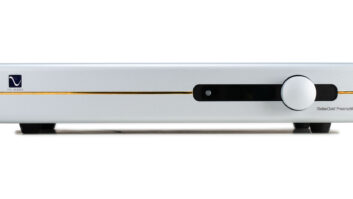As much as we fuss and nitpick and try our best to convey our weary sighs in print when faced with an overly complicated piece of gear, we CE journalists secretly thrive on troublesome installations. They give us something juicy to write about.
So I daresay you (the installer) will find yourself fonder of PS Audio’s PerfectWave DAC (digital audio converter) than I (the scribe) am at the moment. Because within minutes of pulling the PerfectWave out of the package–an experience in and of itself, with the device floating between two sandwiched sheets of clear Mylar instead of packed in Styrofoam, and swaddled in an organic cotton sleeve, topped with two white gloves–I had the system up and running, streaming music from my PC to the theater from the other side of the house, with a level of fidelity that I quite frankly have trouble conveying without resorting to words that aren’t fit to print.

PS Audio’s PerfectWave DAC (digital audio converter)
As sophisticated a device as the PerfectWave DAC is, it has no right being this easy to configure. I should have been able to eke a good 200 words at least out of setting it up for my home network. But no, the instant I plugged an Ethernet cable into the PerfectWave Bridge (a $799 add-on to the $2,999 DAC that transforms it from a traditional digital-to-analog converter into a networkable beast), the devices acquainted themselves with no effort on my part. Even downloading and configuring the company’s $10 tagNplay iPhone/iPod Touch control app was so quick and easy it hardly bears mentioning.
Don’t get the impression from all the talk of networking and control apps that the PerfectWave DAC is only, or even primarily, a streaming audio device, mind you. It seems that PS Audio has set out to build the DAC to End All DACs with the PerfectWave–a lofty goal for a company known primarily for power conditioners and powerproducing paraphernalia–and I’m inclined to say that they’ve succeeded. In addition to AES/EBU, coaxial digital, and optical, it also boasts a pair of I2S inputs for use with high-end CD/DVD transports.
Unfortunately, with no PerfectWave Transport on hand, I didn’t get put the I2S in’s to the test. (That would be another review in and of itself) but in addition to the PerfectWave Bridge setup, I did also try out a direct connection to my PC via USB, hoping for at least a lengthy driver installation or some other sort of technologically fussiness. Nope. As soon as the connection was made, the drivers installed themselves automatically, and within moments I found myself listening to some of the most deliciously rendered uncompressed AIFF and FLAC files my ears have ever been treated to.
Digging through the DAC’s front-panel touchscreen in hopes of finding some complicated, esoteric menus to complain about, I discovered all sorts of filters whose functions I have to admit I still don’t entirely grok well enough to explain without resorting to math, with labels like “minimum phase” and “apodising,” and descriptions in the manual that read thusly: “For a typical minimum phase filter designed for 44.1kHz the group delay distortion up to 10kHz is under two samples (less then 46s).”
Ah ha! Complication! Obfuscation! The sort of baffling corksniffery you’d expect from an audiophile device of this caliber! Right? Not so much. PS Audio also has included a handy Auto setting which automatically engages the best filter to match the sample rate of the digital source delivered to it, and I’ll be damned if it doesn’t always sound sumptuous no matter what I feed it. Foiled again.
If I have one genuine complaint (and what kind of review would this be if I didn’t?), I really wish the PerfectWave DAC had a mini jack input on the back for IR input. The IR receiver on front isn’t as receptive as it could be, and it’s a crying shame to have to sully the front of such a beautiful piece of gear with an IR repeater.

A closer look at the PCB inside PS Audio’s PerfectWave DAC
With nothing else left to complain about, I kicked back with a glass of Delirium Noel for some A/B comparisons and serious listening. Before the head on the Noel had settled, I’d had enough of that, though. I can’t help but recall my review of the Micromega’s WM-10 AirStream from a few months ago, in which I spent hours comparing to my $400 iPod dock to discern improvements in sound quality. They were there, to be sure, but it was a hard sell.
With the PerfectWave DAC, there’s simply no contest. Moving from DAC to dock is like dropping by the DQ for dessert after dining at the Cheesecake Factory. The sound is simply richer, deeper, smoother, and better defined than with any other device in my system, past or present, whether listening to uncompressed tracks or 320kbps MP3s (which PS Audio recommends against, but what can I say? I’m a rebel). I don’t even get to do the obligatory adjective-filled spiel about the strings in this song or the horns in that song ringing through with more warmth or spaciousness compared to other sources, because no other source I’ve heard recently is worthy of the comparison.
866.406.8946
www.psaudio.com
Kudos
PS Audio’s PerfectWave is like the ultimate Swiss Army Knife of DA Cs, doing everything you could ever ask a digital-to-audio converter to do, and doing it all amazingly well.
Concerns
The device is so good it forced me to resort to the tired old “Swiss Army Knife” simile. Oh, and it would be nice if it had a back-panel IR input or an RS -232 jack for control.
Product Specs
■ Direct output to power amplifier
■ Polarity inversion control
■ Sample rate converter bypass
■ 6 sample rates
■ 5 assignable filters
■ 7 digital inputs (one internal)


